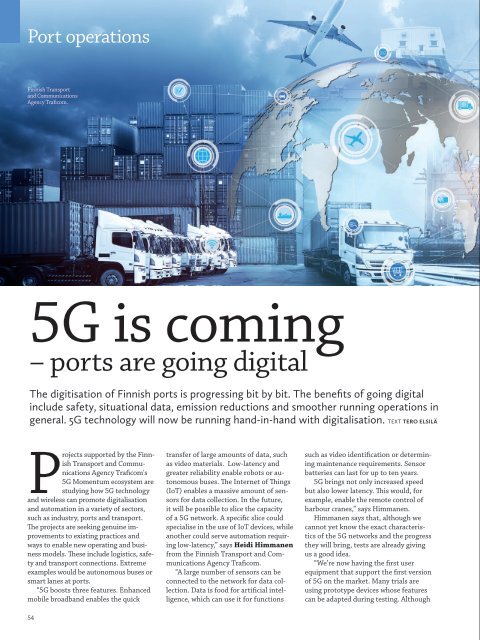You also want an ePaper? Increase the reach of your titles
YUMPU automatically turns print PDFs into web optimized ePapers that Google loves.
Port operations<br />
<strong>Finnish</strong> Transport<br />
and Communications<br />
Agency Traficom.<br />
5G is coming<br />
– ports are going digital<br />
The digitisation of <strong>Finnish</strong> ports is progressing bit by bit. The benefits of going digital<br />
include safety, situational data, emission reductions and smoother running operations in<br />
general. 5G technology will now be running hand-in-hand with digitalisation. TEXT TERO ELSILÄ<br />
Projects supported by the <strong>Finnish</strong><br />
Transport and Communications<br />
Agency Traficom's<br />
5G Momentum ecosystem are<br />
studying how 5G technology<br />
and wireless can promote digitalisation<br />
and automation in a variety of sectors,<br />
such as industry, ports and transport.<br />
The projects are seeking genuine improvements<br />
to existing practices and<br />
ways to enable new operating and business<br />
models. These include logistics, safety<br />
and transport connections. Extreme<br />
examples would be autonomous buses or<br />
smart lanes at ports.<br />
“5G boosts three features. Enhanced<br />
mobile broadband enables the quick<br />
transfer of large amounts of data, such<br />
as video materials. Low-latency and<br />
greater reliability enable robots or autonomous<br />
buses. The Internet of Things<br />
(IoT) enables a massive amount of sensors<br />
for data collection. In the future,<br />
it will be possible to slice the capacity<br />
of a 5G network. A specific slice could<br />
specialise in the use of IoT devices, while<br />
another could serve automation requiring<br />
low-latency,” says Heidi Himmanen<br />
from the <strong>Finnish</strong> Transport and Communications<br />
Agency Traficom.<br />
“A large number of sensors can be<br />
connected to the network for data collection.<br />
Data is food for artificial intelligence,<br />
which can use it for functions<br />
such as video identification or determining<br />
maintenance requirements. Sensor<br />
batteries can last for up to ten years.<br />
5G brings not only increased speed<br />
but also lower latency. This would, for<br />
example, enable the remote control of<br />
harbour cranes,” says Himmanen.<br />
Himmanen says that, although we<br />
cannot yet know the exact characteristics<br />
of the 5G networks and the progress<br />
they will bring, tests are already giving<br />
us a good idea.<br />
“We’re now having the first user<br />
equipment that support the first version<br />
of 5G on the market. Many trials are<br />
using prototype devices whose features<br />
can be adapted during testing. Although<br />
54

















